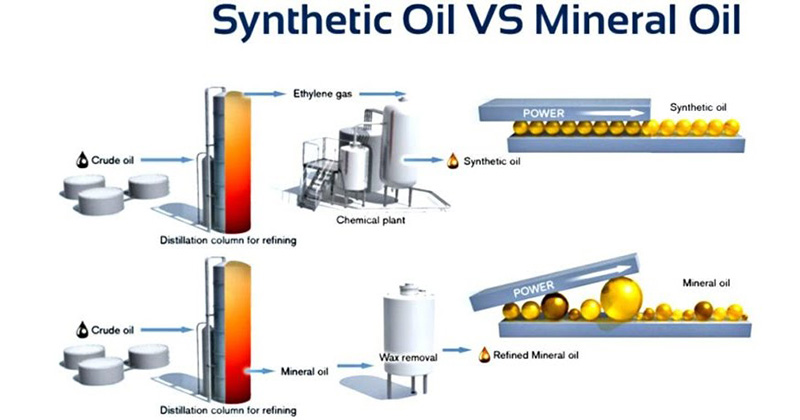In a nutshell
-
Full Synthetic Motorcraft oils are blended on a poly‑alpha‑olefin (PAO) base whose molecular chains are engineered during synthesis to deliver the required viscosity, thermal stability and low volatility.
-
Semi Synthetic Motorcraft oils replace part of that PAO with high‑quality hydrocracked base stock, making the product more affordable but with a slightly lower safety margin against heat and oxidation.
Below are ten key differences, selection tips and cost estimates for various Ford engines. Both oil types comply with Ford specifications.
1. Base oils: what they are and why they matter
-
PAO (Group IV). Produced from refinery gases (ethylene, butylene). Chain length and branching are set in the reactor, delivering outstanding high‑temperature stability, very low volatility and excellent flow at sub‑zero temperatures.
-
Hydrocracked base (Group III). Deeply refined mineral oil with a viscosity index of about 120–130 mm²/s; the process is cheaper, molecular structure is less uniform, so a stronger additive package is required.
2. Production technology

Full Synthetic Motorcraft oils are engineered so that the desired properties are built‑in—molecules are literally “assembled like LEGO.” Semi Synthetic variants are blended from existing fractions, with performance tuned by the PAO‑to‑hydrocrack ratio.
3. Comparison table (typical values)
| Parameter | Full Synthetic | Semi Synthetic |
|---|---|---|
| Thermal stability, °C | ≈ 220 | ≈ 180 |
| Pour point, °C | –45 … –55 | –30 … –38 |
| NOACK volatility, % | < 10 | 11 – 15 |
| Viscosity retention (100 k mi) | High | Medium |
| Oil‑change interval, km | 10 000 – 15 000 | 7 000 – 10 000 |
| Turbocharger protection | Maximum | Adequate |
4. Who should use Full Synthetic Motorcraft
-
Turbocharged or high‑output EcoBoost engines.
-
Vehicles covering 25 – 30 k km per year with extended service intervals.
-
Harsh climates (‑30 °C winters, +40 °C summers).
-
Heavy loads: towing, frequent track days.
5. Who can safely choose Semi Synthetic Motorcraft
-
Naturally aspirated Duratec engines up to 200 k km.
-
Mostly urban driving with annual seasonal oil changes.
-
Moderate driving style without sustained high loads.
6. Common myths
Myth 1. “Semi‑synthetic is basically mineral oil.”
Fact: modern hydrocracked bases already meet API SP; the PAO fraction adds extra durability.
Myth 2. “Full Synthetic is always thinner.”
Fact: viscosity is set by the SAE grade (5W‑20, 5W‑30, etc.). The real difference is how well the oil keeps that viscosity after 5 – 10 k km.
7. How to choose the right genuine Ford oil
-
Check the Ford spec in your service book: WSS‑M2C948‑B, WSS‑M2C913‑D, etc.
-
Select the SAE grade recommended in the owner’s manual (e.g., 5W‑20).
-
Match usage: daily cold starts and a turbo → Full Synthetic; short trips and a naturally aspirated engine → Semi Synthetic is fine.
8. Where to buy verified Motorcraft oil
-
Motorcraft SAE 5W‑20 Full Synthetic — see “Genuine Ford Motor Oils” in our catalog.
-
Motorcraft SAE 5W‑30 Semi Synthetic — same section.
Need help? Enter your VIN in the request form—our technician will match the correct oil free of charge.
9. Conclusion
Genuine Motorcraft Full Synthetic offers maximum protection, longer change intervals and superior stability. Semi Synthetic provides a cost‑effective balance that suits most naturally aspirated engines with regular maintenance. Follow Ford’s spec, monitor the oil level and your engine will run long and trouble‑free.
For consultation call +38 (098) 961‑06‑60 — “Territory Ford.”






